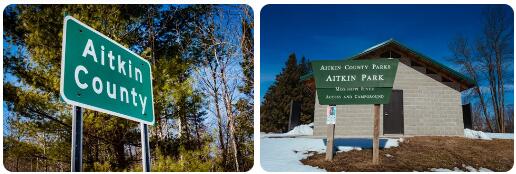
Aitkin County is a county located in the north-central region of Minnesota, United States. It is part of the Brainerd Micropolitan Statistical Area. At 845 square miles, Aitkin County is the largest county in Minnesota by area and is home to an estimated 16,871 people as of 2019.
The county was founded in 1857 and named after William Alexander Aitken, a fur trader and early settler who established a trading post at the junction of two rivers. The two rivers are now known as the Mississippi and Rum Rivers. Aitkin County was originally inhabited by Ojibwe people who lived in villages along the rivers and lakes of the area.
Aitkin County has a mix of rural townships and small cities that are interspersed with lakes, rivers, forests, and farms. The landscape varies from rolling hills to flat prairies to steep ravines with numerous waterways running throughout the county. The majority of the land is covered with forests containing maple, oak, ash, birch, aspen, elm, pine trees, among others. There are also wetlands and grasslands scattered throughout the area providing habitat for wildlife such as deer, moose, beaver and bear.
The climate in Aitkin County varies from season to season but generally consists of cold winters with occasional snowfalls followed by warm summers with occasional thunderstorms. Average temperatures range from highs in the mid-80s Fahrenheit (29 Celsius) during July to lows around -2 Fahrenheit (-19 Celsius) during January.
The economy in Aitkin County is mainly focused on agriculture and natural resources such as timber harvesting and fishing/hunting tourism due to its many lakes and forests. Other industries include manufacturing (including paper products), retail trade (mostly related to tourism), health care services (especially medical clinics), construction (mainly residential buildings), finance/insurance services (banks) ,and educational services (public schools).
Aitkin County has many recreational opportunities for residents including camping on public lands or at one of its many private campgrounds; fishing for walleye or northern pike; hunting deer or other game; boating on any one of its numerous lakes; snowmobiling on hundreds of miles of groomed trails; cross-country skiing or snowshoeing; hiking trails through state parks or nature preserves; golfing at public courses or resorts; visiting historic sites like Fort Ripley State Park or Grand Rapids Dam National Historic Site; bird watching at nearby wildlife refuges or sanctuaries; biking along scenic roads or trails; sightseeing at local museums like Marcell Historical Museum & Cultural Center or Mille Lacs Indian Museum & Trading Post; visiting wineries like Northland Winery & Vineyard Tours; enjoying live music venues like Grand Casino Mille Lacs Event Center; attending festivals like Aitkin County Fair; or simply relaxing on one of its many beaches that line its lakeshores.
Overall, Aitkin County offers something for everyone from outdoor enthusiasts looking for adventure to those seeking some peace and quiet away from it all. Its vast stretches of wilderness combined with its small town charm make it an ideal destination for anyone looking for an escape into nature without sacrificing modern comforts such as shopping centers, restaurants, and entertainment venues.
History of Aitkin County, Minnesota
Aitkin County, Minnesota is located in the north-central part of the state and has a population of approximately 16,000 people. The county was officially established in 1857 and was named after William Alexander Aitken, a Scottish-born fur trader who lived in the area.
Prior to European settlement, the area that is now Aitkin County was home to numerous Native American tribes including the Dakota (Sioux), Ojibwe (Chippewa), and Menominee. These tribes relied on hunting and fishing for subsistence, as well as gathering wild rice for food.
The first permanent non-Native American settlers arrived in Aitkin County in 1853. The majority of these settlers were from Sweden and Finland, with a few from Germany and other countries. They quickly established small farms throughout the area and built sawmills along rivers to take advantage of the abundant timber resources.
In 1865, railroads began connecting Aitkin County with other parts of Minnesota. This led to increased trade with nearby towns and cities and allowed for an influx of immigrants from Europe looking for work in logging camps or on farms. By 1900, most of Aitkin County’s population was made up of Scandinavian immigrants or their descendants.
During this time period, many small towns were established throughout Aitkin County such as McGregor, Palisade, Hill City, Jacobson, Malmo, Tamarack City, Riverton, Glen Township (now known as Isle), Swatara Township (now known as McGregor), Spencer Brook Township (now known as McGrath), Mission Township (now known as Trommald) among others. These towns provided essential services such as schools and churches to local residents while also serving as trading posts for goods from outside the county.
In recent years, Aitkin County has become an increasingly popular tourist destination due to its beautiful lakeside scenery and abundance of outdoor activities such as fishing, hunting, camping and boating. In addition to tourism there is also a thriving agriculture industry which produces crops such as corn and soybeans along with livestock including beef cattle and dairy cows. The logging industry is still active in certain parts of the county though it has declined significantly since its peak during the early 20th century when over 80% of Minnesota’s lumber was sourced from within its borders.
Overall, Aitkin County has had a long history full of change but one thing remains constant; it is still an important part of Minnesota’s cultural heritage today just like it was when it was first settled by European immigrants over 150 years.